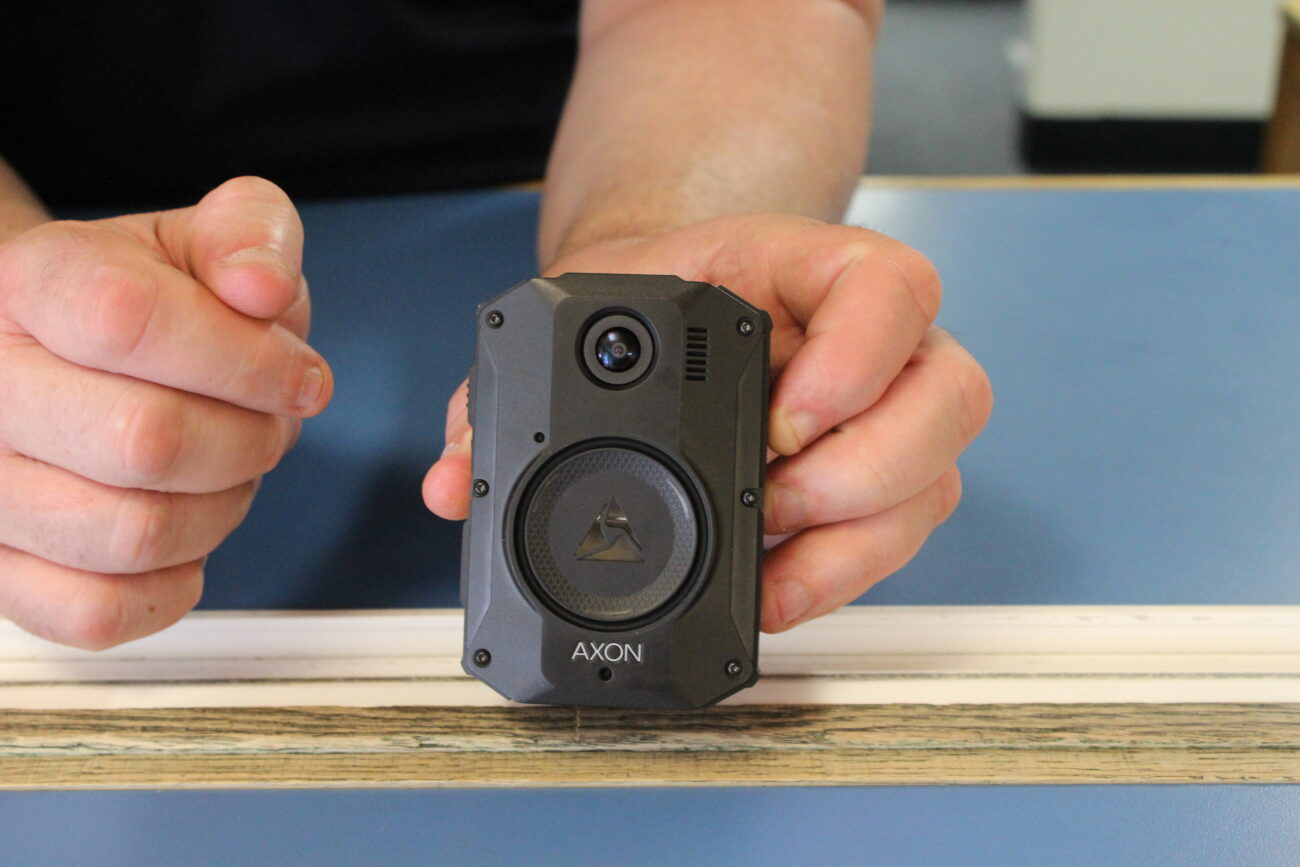
(Sage Smiley / KSTK)
Police in Wrangell were recently equipped with body cameras that log an officer’s interactions with the public. It joins departments in larger cities like Juneau and Ketchikan which have body cams as standard issue.
It’s a quarter past 1 on a Sunday morning, and the red and blue lights of a Wrangell police cruiser are flashing. Officer Yuriy Bezzubenko has just made what appears to be a routine traffic stop of a pickup truck with passengers riding in the back. He picks up the radio from the dashboard to call in the traffic stop, then double taps a device on his chest which activates the bodycam’s microphone.
He gets out of the car, shuts the door, and walks forward.
“Hey guys, are there seat belts attached to that truck bed?” he asks.
For the next 20 or so minutes, the traffic stop proceeds like any other, just viewed from the chest-level perspective of Officer Bezzubenko.
“Do you mind if I see a license and registration and proof of insurance please?” he continues.
Footage of the interaction is the first released by Wrangell’s police department from their new body-worn cameras. KSTK requested the footage on June 17 through a public records request. It was delivered eight days later.
The seven new cameras were purchased using about $35,000 of federal pandemic relief. They’re made by Axon, a company that also makes Tasers and other law enforcement tech. A good chunk of the money went towards paying for five years of secure cloud storage for body cam footage. Police Chief Tom Radke requested the purchase last year.
“It’s another tool that is in the law enforcement toolbox,” Radke said in an interview earlier this month. “And we want to be transparent with people. We want to be upfront with people. And this is just a way to accomplish that.”
Wrangell’s assembly approved the department’s body cam policies in mid-June with little fanfare.
The policy is fairly clear-cut. Officers should wear the camera while in uniform, and record most interactions with the public. If an interaction isn’t recorded, there has to be clear justification for why it wasn’t.
The cameras upload footage automatically to the storage site. If the footage is evidence in a criminal case, it has to be stored for at least 10 years. Recordings that aren’t evidence will be stored by the department for 90 days.
Police body-worn camera footage is public record in the same way that other police records are public. Evidence that is being used in an ongoing investigation wouldn’t be released until the investigation is complete.
The department’s body cam policies don’t lay out clear standards for what will and won’t be publicly released. Radke says it will be a case-by-case consideration for himself and other Wrangell officials.
He says there’s a balance to be struck: “Going forward, we want to be as transparent and as fast [at releasing footage] as we can be, with also affording the rights of those that are being accused.”
And, he says he worries about fueling the small-town rumor mill: “One of my biggest fears is, you know, there’s something that happened over the Johnsons’ house, and somehow, just because you’re the nosy neighbor five doors down, you come in here and want to get into the Johnsons’ business, you know, what I’m saying?”
Protecting privacy is important to Radke, as the department smooths the wrinkles in its body camera policies.
For example, in the footage released to KSTK, the audio cuts for a few seconds to mute identifying information of the driver. Radke says there’s also an option to put a black box over something like a license, to protect people’s privacy. But officers don’t have the option to edit the footage by removing a few seconds here or there. That’s part of the function of offsite storage. The cloud storage also logs every time someone looks at the footage.
Radke says the policies could shift slightly, as the department learns more about everyday use of the cameras.
“These are set in stone,” Radke explains, “But they’re not set in stone, you know, what I’m saying? As far as: we might have to add some things to them that we just didn’t anticipate.
Radke says there haven’t been any issues with the rollout of the body cams yet — although some officers are still figuring out what sort of holster and chest placement works best for them.
As far as public interactions go, Radke says the cameras are very unobtrusive.
“A lot of people — a good percentage of the people, I don’t think will even see them,” he says. “They’re dark-colored. They blend in with the uniform.”
Radke adds the police department is planning on holding community engagement events to educate Wrangell and take input about body-worn cameras. But those haven’t been scheduled yet.
Get in touch with KSTK at news@kstk.org or (907) 874-2345.











